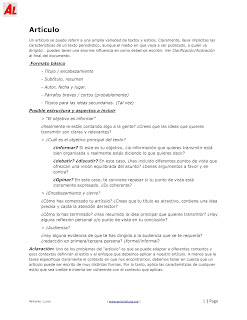 Writing skills have to be combined with text features deep knowledge to have the opportunity to score highly in your exams. Being a great writer also means knowing the specific features of each type of text to be able to reach the expectations of your readers and to make sure your intentions materialize on paper. That is the perfect combination to score highly in your Paper 2 and Written Assignment.
Writing skills have to be combined with text features deep knowledge to have the opportunity to score highly in your exams. Being a great writer also means knowing the specific features of each type of text to be able to reach the expectations of your readers and to make sure your intentions materialize on paper. That is the perfect combination to score highly in your Paper 2 and Written Assignment. The article is a very open, and therefore complicated, text type. It can be very heterogeneous in terms of features, audience, communicative goal and structures. But basically, you can divide this text into three different sections with two different intentions:
- Communicate information to inform your audience [objective]
- Express and opinion trying to persuade your audience about something [subjective]
There are so many different good resources out there that's why in this post besides attaching my documents I've made a compilation of what I think are the best resources available online.
Goal: To inform a targeted audience. [Texto expositivo/informativo]
This type of text is constructed to tell or advise you on something.
Useful links:
|
Goal: To debate/discuss ideas. [Textos expositivos y argumentativos]
To be able to debate ideas and convince people you will need to present the information and provide different perspectives, contrast information and express your opinion.
Don't forget to include advantages and disadvantages, positive and negative sides of the argument...
You will need to combine both types of texts and their features.
|
Goal: To express an opinion and/or have an impact on somebody's opinion. Artículo de opinión. [Texto argumentativo/persuasivo]
Usually this type of text is written to make you do something: persuade about something, buy an item...
Useful links:
|
- Artículo [Wikipedia]
- Types of texts with activities [Lenguaparaeso] [pdf]
- Essential information on Articles [Antonio Luna] [pdf]
- Different types of texts [BBC]
Develop a passion for learning.
If you do, you will never cease to grow.
Anthony J. D'Angelo











